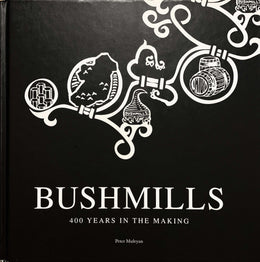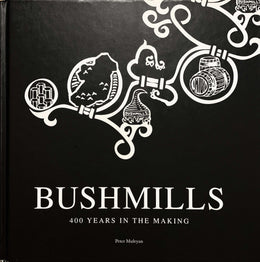
An old advertisement for a famous brand of Whisky humorously recounted how to prepare your own homemade malt spirit. This funny little story talks about the production of Whisky more effectively than most bogged technical descriptions.
The literal translation is as follows.
Firstly, procure a bit of water from the Scotch hills, add an adequate amount of barley and let it soak for 48 hours.

Then, drain it and lay it on a clean and fresh floor. The barley will begin to grow, to ferment and in the meantime, warm up again. Find a wooden paddle and, to keep it nice and fresh, keep turning over the barley, spreading it more and more, until you have an extremely thin layer. Since it will be fermenting 24 hours a day, it might be the case to set an alarm clock on your bedside table, so that you can wake up often enough to flip the barley over. Don't worry though, this will go on for 11 days, so during your free time you should build a fireplace, upon which you'll erect a small brick tower. Halfway through, you'll have to add a metal sieve, and cover that with an imitation-Chinese pagoda made of wood. You're going to have to make a pretty big hole in the ceiling, and let the pagoda rise towards the sky.
Your barley, in these 11 days, will have grown out roots and buds. Take it, and gently lay it down at the bottom of the sieve. What you have achieved thus far is called malt.
Now you have to start a nice peat fire in the fireplace. Peat is nothing but a special type of fuel formed throughout the centuries, extracted in spring from the bottom of dried up lakes, also known as bogs, and thoroughly dried under what little sunlight that the following Scottish summer could offer. This fuel is very important, since the peat smoke, that has a particularly nostalgic and penetrating aroma, gives a bit of that flavor to the drying malt and consequently to the Whisky as well, infusing it with the taste and character of something similar to the way smoke given off of wood chips make for a delicious and appetizing smoked ham and herring.
Every 3 hours stir the drying malt, otherwise the portion closest to the fire will burn. Unfortunately the fire should never go out, and you'll also notice soon enough that the working conditions aren't exactly pleasant. Additionally you will notice that the smoke is particularly piercing and that your clothes will probably be impregnated of it for at least 4 or 5 days.
After having smoked both the malt and yourself, you can finally put the fire out. You’ll find the malt dry and hardened.
Remove the root and bud of each grain, one by one, and feed it to the birdies.
Then, grind your barley grains and set them in boiling water, shaking it vigorously. Drain it, letting it cool, and add a little yeast, which you can buy at the baker’s.
Soon you will see a few bubbles appear on the surface and the malt sugar will be gradually absorbed by the yeast and have become a weak form of alcohol. Let this process of transformation go on for 3 days, but beware of tasting it: the flavor is disgusting. In Scotland they call it "wash" and is, in other words, malt must.
A few weeks beforehand you shall have to bring a large onion to your local tinker, asking him to reproduce it in copper, sufficiently sized to contain your must.
Now you'll have to fill your onion, weld the top to a thin corkscrew-sha ped tube (which is generally called "condensing coil') and, to keep it cool, immerse it in running water.
Start one of those rickety, old oil burners under the onion, and wait for the first drops to come out the other end of the still. When the precious drops have stopped, empty the still, clean it carefully, then put the product of your first distillation back into it and start over from the beginning.
You probably will not recognize what you've so laboriously obtained, but if you were in Scotland, if you placed it in an oak cask and left it there for at least three years, then - and only then - would you be allowed to call it
"Scotch Whisky"
However, since you've done all of this illegally, you won't be allowed to call it anything, actually you'd be better off, in this respect, shutting up.
But if you live somewhere else other than Scotland, you'll just have made a bit of Whisky. Maybe it's good, maybe it's bad; no one can know how the product of a new distillery will turn out, until it's been made, aged and tasted.
Stocked barley, perfectly clean and dry, then undergoes its initial processing. This intervention, called "malting", consists of - as the word itself says - the transformation of barley into malt. In other words, the starch contained in the grains turn into fermentable sugars. The maltose which is obtained in this operation is, in fact, a soluble and crystalline sugar.
During this operation the production of enzymes is stimulated, these organic substances which act as catalysts in the conversion of starch into sugar. One of these enzymes (cytase) is needed to soften the toughest part of the barley grain, allowing the other enzyme (diastase) to attack the starch it contains to make it soluble (dextrin) and, at the same time, transform into fermentable sugar (maltose). Malted barley therefore contains those sugars that, through the following steps, will bear alcohol.
Malt is not only used as a source of starch, but mostly as a source of enzymes. In Scotch Malt Whisky, where only malted barley is used, the activity of the enzymes is used only partially. In other types of Whisky (Grain) instead, malted barley, present in a small percentage compared to other cereals, is employed only as a source of enzymes, so that their activities may act on the starch in a mass of non-malted cereals, while also saving considerably on the cost of malting.
In practice, the malting process is conducted by taking green barley from silos and conveying it to pulping mills, where it is left to soften immersed in cold water. Steeping time varies, depending on the barley's quality and the weather conditions, from a minimum of 48 to a maximum of 70 hours. The percentage of humidity must correspond to 40-45%.
After it's been drained, the barley is laid out on the floor of a large room in the distillery (called the "malting floor") and moved again and again with wooden paddles for about 14 days.
Meanwhile, the grain germinates, puts out a rootlet, and takes in oxygen while expelling carbon dioxide. The carbon dioxide creates a great amount of heat, and turns the environment asphyxiating, to the great discomfort of the workers who are entrusted with keeping the barley at a steady temperature of 15 °C.
The barley, with its small bud that should not exceed five-eighths of its very own grain size, goes into an oven whose heat causes the end of the germination and, at the same time, the desiccation of the grain. The inhibition of the germination ensures that the bud does not sap the barley sugar content for its growth.
A few meters below the holed floor of the oven upon which the germinated barley is held, a peat fire is lit, which releases an acrid and pungent smoke.
Peat, consisting of herbaceous and ligneous plants at the first stage of carbonization, in addition to drying barley, allows for the condensation of important organoleptic components that will confer that aroma and taste so typical of Scotch Whisky.
We can distinguish three different phases in peating: the aqueous, the oleaginous and the waxy. Only the first two leave traces of phenols and related substances, which release the characteristic scents of phenic acid (the aqueous solution of phenol) and, in some cases, of marine iodine. The percentage of these phenols must be chemically ascertained, and not only through olfactory examinations, since this fragrance, vaguely reminiscent of a pharmaceutical, plays an incredibly important role in the final flavor of a Scotch. This is the only moment when I feel that chemistry is of any use to the proper run of the production.
The joint processes of malting and peating cease when, as Scottish author Neil Gunn states, you can write your name on a wall with a grain. Only then will it be ready to be ground.
The manual method of mixing pulped barley has been since then modified by making use of mechanical shovels (Saladin Malting), thereby significantly improving the conditions of the workers, and the cost factor.
I have nothing against these forms of automation that, in addition to being modest changes, are prearranged at the distillery and customized.
My doubts worsen however when all these operations are standardized, as I have already said, outside the distillery. The element of craftsmanship disappears, and all procedures that precede fermentation and distillation are carried out industrially.
The operation is largely standardized due to the colossal production size, and the fact that they use coke and anthracite to develop greater heat, and only a small, standard quantity of peat for fragrance. The "grist", the malt flour made out of it, is then distributed to various distilleries, who, after fermentation, distill it.
I visited one of these modern factories in Lossiemouth, near Elgin, in the north of Scotland. The building is gigantic, with tall silos, huge electronic control panels, imposing pipes which extend both vertically and horizontally. I saw lines of trucks unload barley and wagons full of grist whose destinations were marked by flashy signs sided by advertisements of the most important brands. Large scale economies were perhaps indispensable for the assured upkeep of market shares of the whiskey industry, but there were significant drawbacks as well: the loss in quality, philosophy and humanity.
Written by Silvano Samaroli
The text is an excerpt from "Whisky Eretico" (pp. 46 - 50), written by Silvano S. Samaroli, published 2017 by The Whisky Library, The Library Group Limited.







